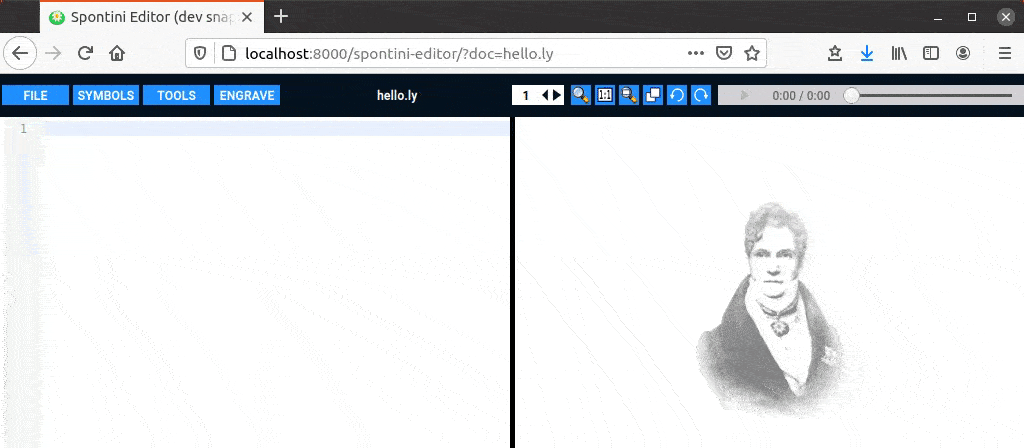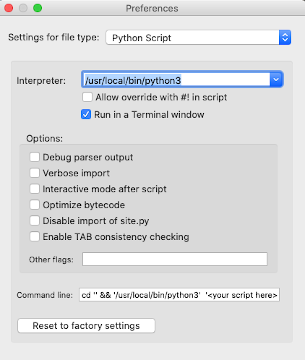Complex music engraving made possible and fast
Spontini-Editor is a text-combined-with-graphic music editor that strongly speeds up the creation and fine graphic tuning of complex scores edited with LilyPond through two main features:
-
It allows the positioning of musical objects (articulations, texts, pedals, curves, brackets etc.) with the mouse, both for "avoid-collisions" properties (X/Y-offset, staff-padding, outside-staff-padding, padding) and for extra-offset property. Once the positioning is graphically done, the text editor reports the corresponding changes on the input file: these changes are written in standard LilyPond code and do not require any additional software to be compiled.
-
It assists in the creation of piano music by inserting notes in tabular and formatted form. It also supports cross-staff scores through a set of work-arounds (invisible to the user) that solve many issues of the native cross-staff functions.
Other main features:
- Multi-platform (written in Javascript and Python 3)
- Web server + HTML client architecture: the client runs, without any installation, on the main browsers (currently compatible and tested on: Chrome, Chromium, Firefox, Brave. Not compatible with Pale Moon, nor with Safari), thus allowing to edit LilyPond documents with cheap and small boards, like Raspberry PI. The client works on Android tablets too, provided you use a keyboard + touchpad or mouse with them.
- The application server is made with a main layer which runs on the main Python ASGI platforms, like Uvicorn, Daphne etc; it supports both SSL and Tor for security, and all the features provided by the Python ASGI servers
- Plugin engine that can interface to any library/utility suitable for LilyPond; implemented plugins currently support: Abjad, python-ly, musicxml2ly and VLC; plugins can be created as well by the users through a XML API (which interfaces to external scripts)
- Python 3 scripting interface
- A pure HTML midi player is included (Magenta through html-midi-player, ready to be used on the browser)
- Pan-zoom advanced interface
- Multiple layouts
- "Fork-mode" for collaborative remote editing
- Code completion
- Quick insert for a set of notation symbols
- Self-installable in embedded environment (venv)
- Smart tools for extracting parts from the score
Note that Spontini-Editor is NOT a WYSIWYG notation editor (like Finale, Sibelius etc.). It only uses the graphical interface to avoid the waste of time caused by LilyPond functions that require the trial-and-error process. All the functions that do not require this process have been intentionally left to be implemented with the only text editor, in pure LilyPond language, which must therefore be known in advance by the user: through the knowledge of this language, and adding the Spontini-Editor functions to it, you can get a much faster editing process than WYSIWYG editors. In addition, as can be seen in the documentation below, the conversion of the Spontini-Editor functions into native LilyPond code can be obtained by changing simple strings in the corresponding musical expressions.
Spontini-Editor's text editor component uses Codemirror library, which it will automatically download from the cloud.
Thanks to Aaron Hill, Thomas Morley, Martin Tarenskeen and the #regex, #javascript and #python irc channels (freenode) for the support in doing this!
-
1) Install LilyPond with version >= 2.19.84 (included) and <= 2.22.0 (included)
2) Install Python 3.6 or newer
On Debian based distros (Ubuntu, Mint etc.) just use:
sudo apt install python3 python3-tk python3-pip python3-venv
-
1) Install LilyPond with version >= 2.19.84 (included) and <= 2.22.0 (included)
2) Install Python 3.6 or newer
-
1) Install LilyPond with version >= 2.19.84 (included) and <= 2.22.0 (included)
If you installed an unofficial 64-bit application bundle (macOS >= 10.15.0) you need to add LilyPond to your PATH:
export PATH="${PATH}:/Applications/LilyPond.app/Contents/Resources/bin"2) Install Python 3.6 or newer
1) Copy the Spontini-Editor directory wherever you want, run SpontiniServer.py with Python 3 and wait until the setup has been completed.
2) Open the page: http://localhost:8000/spontini-editor with your browser. The editor will appear and it will allow to edit and compile files in the default workspace, which is the "examples" directory of the project.
IMPORTANT NOTE! Keep ALL the files in the main directory at their place, otherwise SpontiniServer.py won't work.
NOTE for Windows users: you can launch SpontiniServer by simply double-clicking on SpontiniServer-WIN.vbs (or SpontiniServer-WIN.bat).
NOTE for macOS users: you can launch SpontiniServer by right-clicking on the file and then choose "Open with" ---> "Python launcher". Make sure that Python launcher is configured for running python 3, as the following image shows:


